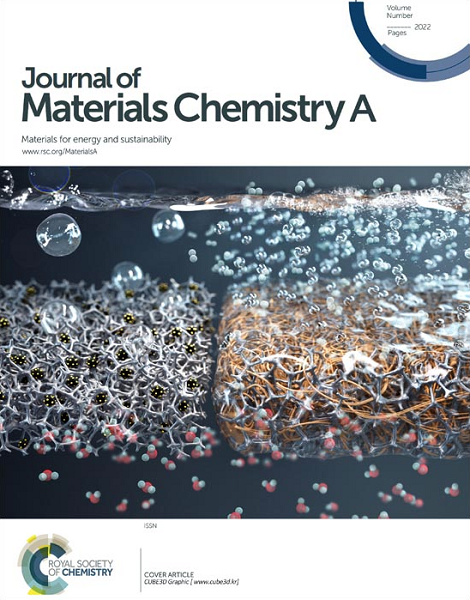碳量子点修饰二硅化钛的合成:一种用于可持续废水处理的新型混合太阳能驱动光催化剂
IF 9.5
2区 材料科学
Q1 CHEMISTRY, PHYSICAL
引用次数: 0
摘要
生产一种高效的太阳能驱动半导体光催化剂是利用最大的太阳能来解决现实世界问题的可持续应用所必需的。本文采用超声-一锅水热法制备了一种新型的纳米二硅化钛/碳量子点(TiSi2/CQDs)复合光催化剂。使用了几种光谱和显微技术来研究成功的复合材料形成,检测到新的静电相互作用以及结晶度,光电和光催化性能的总体增加。在可见光(400W LED灯)驱动下,对TiSi2/CQDs纳米杂化光催化剂分别光催化降解阴离子染料伊红黄(EY)和阳离子染料尼罗蓝(NB)进行了测试。与TiSi2相比,TiSi2/CQD光催化剂的光降解效率为83.7% (NB)和95.1% (EY)。为了模拟真实的废水条件,还对TiSi2/CQD光催化剂在自然光照直射条件下对两种染料(NB/EY)的混合物进行了测试,重点研究了各种参数(即催化用量、初始染料浓度和pH等)的作用及其优化,以达到99%的最大降解效率。通过在TiSi2表面装饰CQDs作为电子储层,增强了TiSi2的光电性能,显著改善了TiSi2的可见光吸收、光电流响应和电荷载流子转移动力学,同时降低了TiSi2的电子-空穴复合速率。结果表明,TiSi2/CQDs复合材料具有良好的光降解性能,可连续循环3次。动力学研究表明,光降解反应符合一级动力学。本文介绍了一种经济、热稳定、相对无毒的金属氧化物基半导体光催化剂,具有优异的可见光活性。本文章由计算机程序翻译,如有差异,请以英文原文为准。
Synthesis of carbon quantum dots decorated titanium disilicide: A novel hybrid solar-driven photocatalyst for sustainable wastewater treatment
Producing an efficient solar driven semiconductor photocatalyst is required for harnessing the maximum solar light for sustainable application in solving real-world problems. In the present work, a novel nanohybrid titanium disilicide/carbon quantum dots (TiSi2/CQDs) based composite photocatalyst was prepared via sonication followed by one-pot hydrothermal treatment. Several spectroscopic and microscopic techniques were used to investigate the successful composite formation with the detection of new electrostatic interactions and an overall increase in crystallinity, optoelectronic as well as photocatalytic properties. The TiSi2/CQDs nanohybrid photocatalysts was tested for the visible light (400W LED lamp) driven photocatalytic degradation of Eosin yellowish (EY) and Nile blue (NB), an anionic and a cationic dye, respectively. TiSi2/CQD photocatalyst showed excellent photodegradation efficiency of 83.7% (NB) and 95.1% (EY) as compared to that of TiSi2. To mimic the real wastewater conditions, the TiSi2/CQD photocatalyst was also tested for a mixture of two dyes (NB/EY) in direct natural sunlight conditions with emphasis on the role of various parameters and their optimization (i.e., catalytic dosage, initial dye concentration and pH etc.) to achieve the maximum degradation efficiency of 99%. The optoelectronic properties of TiSi2 were enhanced by decorating its surface with CQDs acting as an electron reservoir and significantly improved the visible light absorption, photocurrent response and charge carrier-transfer dynamics while decreasing the electron-hole recombination rate. As a result, TiSi2/CQDs composite showed an excellent photodegradation with excellent recyclability up to three consecutive cycles. The kinetic studies showed that the photodegradation reactions followed first order kinetics. This article introduces an economic, thermally stable and relatively non-toxic substitute for metal oxide based semiconductor photocatalysts for excellent visible light activity.
求助全文
通过发布文献求助,成功后即可免费获取论文全文。
去求助
来源期刊

Journal of Materials Chemistry A
CHEMISTRY, PHYSICAL-ENERGY & FUELS
CiteScore
19.50
自引率
5.00%
发文量
1892
审稿时长
1.5 months
期刊介绍:
The Journal of Materials Chemistry A, B & C covers a wide range of high-quality studies in the field of materials chemistry, with each section focusing on specific applications of the materials studied. Journal of Materials Chemistry A emphasizes applications in energy and sustainability, including topics such as artificial photosynthesis, batteries, and fuel cells. Journal of Materials Chemistry B focuses on applications in biology and medicine, while Journal of Materials Chemistry C covers applications in optical, magnetic, and electronic devices. Example topic areas within the scope of Journal of Materials Chemistry A include catalysis, green/sustainable materials, sensors, and water treatment, among others.
 求助内容:
求助内容: 应助结果提醒方式:
应助结果提醒方式:


